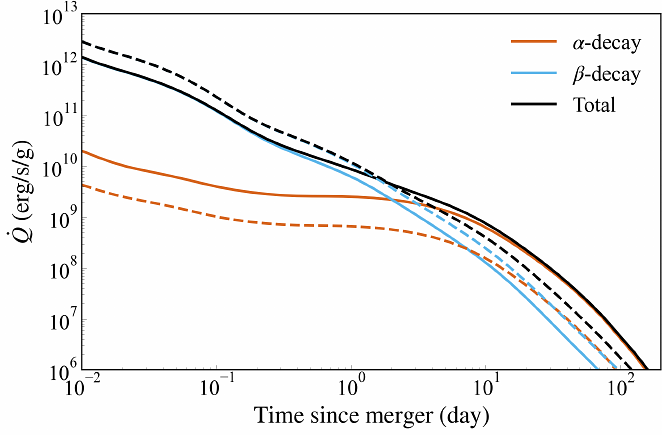A constraint on superheavy elements of the GRB-kilonova AT 2023vfi

A constraint on superheavy elements of the GRB-kilonova AT 2023vfi
Zhengyan Liu, Ji-an Jiang, Wen Zhao
AbstractThe discovery of the kilonova (KN) AT 2017gfo, accompanying the gravitational wave event GW170817, provides crucial insight into the synthesis of heavy elements during binary neutron star (BNS) mergers. Following this landmark event, another KN was detected in association with the second-brightest gamma-ray burst (GRB) observed to date, GRB 230307A, and subsequently confirmed by observations of the James Webb Space Telescope (JWST). In this work, we conduct an end-to-end simulation to analyze the temporal evolution of the KN AT 2023vfi associated with GRB 230307A, and constrain the abundances of superheavy elements produced. We find that the temporal evolution of AT 2023vfi is similar to AT 2017gfo in the first week post-burst. Additionally, the \textit{r}-process nuclide abundances of lanthanide-rich ejecta, derived from numerical relativity simulations of BNS mergers, can also successfully interpret the temporal evolution of the KN with the lanthanide-rich ejecta mass of $0.02 M_\odot$, which is consistent with the mass range of dynamical ejecta from numerical simulations in literature. Both findings strongly suggest the hypothesis that GRB 230307A originated from a BNS merger, similar to AT 2017gfo. Based on the first time observation of the KN for JWST, we are able to constrain the superheavy elements of another KN following AT 2017gfo. The pre-radioactive-decay abundances of the superheavy nuclides: $^{222}$Rn, $^{223}$Ra, $^{224}$Ra and $^{225}$Ac, are estimated to be at least on the order of $1 \times 10^{-5}$. These abundance estimates provide valuable insight into the synthesis of superheavy elements in BNS mergers, contributing to our understanding of astrophysical \textit{r}-process nucleosynthesis.